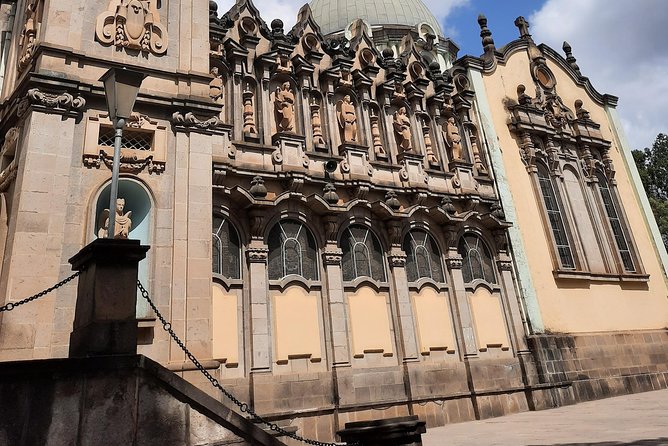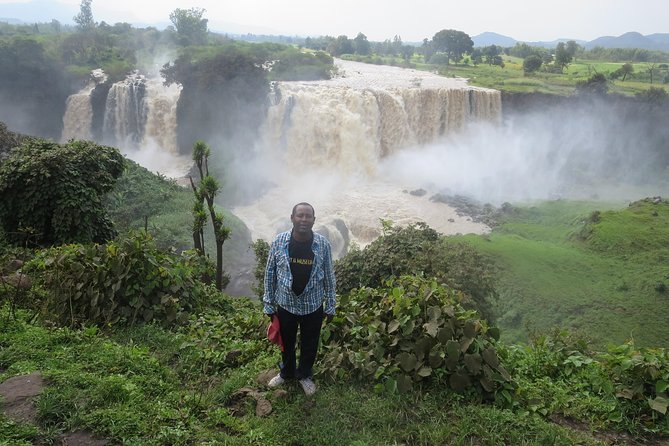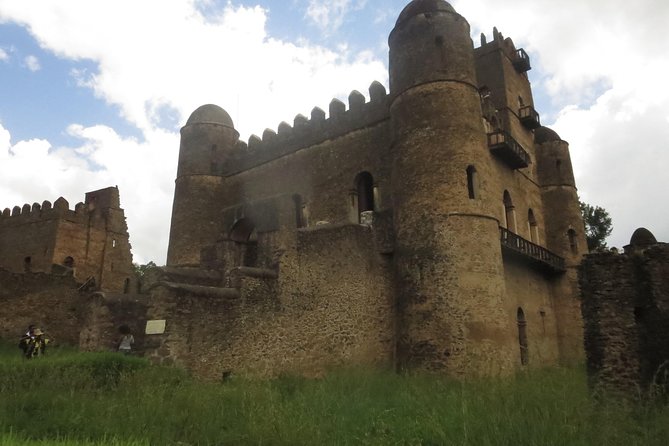One fascinating statistic about Ethiopia’s Historic Route is that it is home to 9 UNESCO World Heritage Sites, showcasing the country’s profound historical and cultural significance.
As travelers embark on this 5-day expedition, they will witness breathtaking landscapes, ancient churches carved into rock, and bustling markets that have stood the test of time.
Each day promises a new adventure, immersing visitors in Ethiopia’s diverse tapestry of traditions and legacies.
With a blend of exploration and relaxation, this journey offers a glimpse into a world where past and present intertwine seamlessly, leaving participants with a lasting appreciation for Ethiopia’s remarkable heritage.
This experience made our list of the 20 Best Historical Tours In Addis Ababa.
Good To Know

- Explore Ethiopia’s cultural landmarks and historical sites in Addis Ababa.
- Discover Bahir Dar’s natural beauty and ancient monasteries on Lake Tana.
- Immerse in Gondar’s historical marvels, including the impressive Gondar Castle complex.
- Engage with Lalibela’s churches carved into rock and witness religious ceremonies for a profound cultural experience.
Day 1: Addis Ababa

Upon arrival in Addis Ababa, travelers will kick off their Ethiopian adventure exploring the vibrant capital city’s cultural landmarks and historical sites on the first day of the 5-day tour.
Immerse in the rich Ethiopian culture by visiting the National Museum, home to the ancient fossil, Lucy, and the Ethnological Museum, showcasing the country’s diverse heritage.
Stroll through the bustling markets, like the Merkato, one of Africa’s largest markets, to witness daily life and pick up souvenirs.
For a taste of local cuisine, indulge in traditional dishes like injera, a sourdough flatbread, paired with spicy stews.
The day ends with a visit to a local restaurant to savor authentic Ethiopian flavors, setting the stage for the cultural exploration ahead.
Interested in history? More Addis Ababa historical sites we've covered
Day 2: Bahir Dar

As travelers embark on Day 2 of the Ethiopian adventure, they’ll journey to Bahir Dar, a city renowned for its picturesque landscapes and cultural attractions.
Bahir Dar is a hub for boat tours on Lake Tana, the largest lake in Ethiopia, offering visitors a chance to explore ancient monasteries and witness the local way of life.
One of the highlights of Bahir Dar is the majestic Blue Nile Falls, also known as Tis Issat, meaning ‘smoking water.’ The falls cascade down a dramatic gorge, providing a breathtaking sight. Travelers can take a short hike to get closer to the falls and feel the mist on their faces.
Bahir Dar’s natural beauty and historical significance make it a must-visit destination on Ethiopia’s Historic Route.
Day 3: Gondar
Exploring the imperial city of Gondar on Day 3 unveils a tapestry of historical marvels, showcasing the rich heritage of Ethiopia’s past rulers. Visitors can step back in time by exploring the magnificent Gondar Castle complex, a UNESCO World Heritage Site boasting royal palaces, libraries, and churches.
The castles, built in the 17th and 18th centuries, reflect the architectural prowess of the Gondarine dynasty. Apart from the architectural wonders, Gondar is also a hub for traditional Ethiopian music, offering a vibrant experience of local culture.
Travelers can enjoy the melodious tunes of traditional music performances, gaining insight into Ethiopia’s musical traditions that have been preserved through generations.
Day 4: Lalibela
Stepping into Day 4 of the journey, travelers are poised to discover the awe-inspiring wonders of Lalibela, a place where ancient rock-hewn churches stand as testaments to Ethiopia’s rich cultural and religious heritage.
Exploring Churches: Lalibela is renowned for its remarkable churches carved directly into the rock, showcasing intricate details and religious significance.
Cultural Immersion: Visitors can engage with local traditions, witness religious ceremonies, and interact with friendly locals, providing a deep cultural experience.
Historical Insights: Guides offer insights into the history and significance of each church, allowing travelers to grasp the depth of Lalibela’s importance in Ethiopian history and spirituality.
Immersing oneself in Lalibela’s churches and culture offers a profound journey into the heart of Ethiopia’s heritage.
Day 5: Return to Addis Ababa
Upon the final day of the expedition, travelers prepare to journey back to Addis Ababa, reflecting on the cultural treasures and historical marvels experienced throughout the past five days.
The return trip offers a chance to savor the diverse local cuisine once more, indulging in traditional Ethiopian dishes like injera with various stews and coffee ceremonies.
The journey back also allows for further immersion in the rich cultural experiences encountered along the way, from the ancient rock-hewn churches of Lalibela to the royal castles of Gondar.
As the travelers bid farewell to the remarkable sites and warm hospitality of Ethiopia’s Historic Route, they carry with them memories of a truly unforgettable adventure that has deepened their appreciation for this unique corner of the world.
More tours and activities we've covered in Addis Ababa
Frequently Asked Questions
What Is the Local Currency in Ethiopia and Where Is the Best Place to Exchange Money?
In Ethiopia, the local currency is the Ethiopian Birr (ETB). The best place to exchange money is at authorized banks, hotels, or forex bureaus. Visitors should also explore local markets, practice traditional greetings, and respect local etiquette.
Are There Any Specific Dress Codes or Cultural Customs to Be Aware of When Visiting Historical Sites in Ethiopia?
When visiting historical sites in Ethiopia, it’s important to respect dress codes and cultural customs. Dress modestly, covering shoulders and knees. Remove shoes when entering religious sites. Greeting with a handshake is common, and it’s polite to accept coffee if offered.
Is It Safe to Drink Tap Water in Ethiopia, or Should I Stick to Bottled Water Throughout the Trip?
When in Ethiopia, it’s advised to stick to bottled water to avoid health risks associated with tap water. Cultural norms and hygiene standards vary, making bottled water a safer choice. Stay hydrated and enjoy the trip!
Are There Any Recommended Local Dishes or Restaurants to Try While on the Historic Route Tour in Ethiopia?
When exploring Ethiopia, visitors can savor local delicacies and culinary experiences. Authentic eateries offer traditional dishes like injera, doro wat, and kitfo. Food recommendations include trying tej (honey wine) and coffee ceremonies for a true taste of Ethiopian culture.
What Is the Best Way to Interact With Locals and Learn About the Rich History and Culture of Ethiopia During the Tour?
To truly experience Ethiopia’s rich history and culture, visitors can engage in culture by interacting with locals, seeking historical insights, and participating in community engagements. This approach fosters a deeper understanding and appreciation of the country’s heritage.
The Sum Up

Set out on a journey through Ethiopia’s Historic Route to uncover the country’s vibrant culture and rich history. From the bustling city of Addis Ababa to the ancient wonders of Lalibela, this 5-day tour promises an unforgettable experience filled with iconic landmarks and local cuisine.
With top-notch amenities and a dedicated team, travelers are sure to be immersed in the beauty and stories of Ethiopia’s past and present. Don’t miss out on this captivating expedition!
More 5-Day Experiences in Addis Ababa
More Historical Tours in Addis Ababa
More Tour Reviews in Addis Ababa
Looking for something different? Other Addis Ababa activities we've written about
- Addis Ababa Insider Tour: Explore with Certified Local Guides
- Mount Entoto View Point, Museum Palace Local Market & Food Tours
- 6 Best Shopping Tours In Addis Ababa
- 8 Best Workshops And Classes In Addis Ababa
- 20 Best Historical Tours In Addis Ababa
- 20 Best 3 Day Tours In Addis Ababa
- 25 Best Tours In Addis Ababa
- 12 Best 2 Day Tours In Addis Ababa
- 9 Best 4 Day Tours In Addis Ababa
- 6 Best Private Driver Services In Addis Ababa
- 19 Best Full-Day Tours In Addis Ababa
- 9 Best Guided Tours In Addis Ababa
